OR/17/002 Work Package 4: Public perceptions: Difference between revisions
m 1 revision imported |
|||
(No difference)
| |||
Latest revision as of 12:53, 7 March 2018
| Chadwick, R A. 2017. DiSECCS Final Summary Report. Work Packages 1 – 4 British Geological Survey Internal Report, OR/17/002. |
This Work package is framed around the social licence to operate (SLO) concept, which goes beyond ‘acceptance of’ or ‘support for’ a particular technology, recognising complexities in the relationships between communities and technologies (Batel et al., 2013[1]). Key to this is an understanding of the wider social context in which a technology is to be deployed (Ashworth et al., 2012[2]; Bradbury et al., 2009[3]). SLO can be broadly defined as informal permission given by the local community and broader society to industry to pursue technical work (Thomson & Boutilier 2011 quoted in (Dowd & James, 2014[4])). The SLO concept is yet to become widely established within the context of CCS; moreover, research in Australia suggests that, given the limited experience and awareness of CCS technology amongst the wider public, any SLO for CCS remains highly provisional and, hence, fragile (Dowd & James, 2014[4]). In this context we argue that it is important to explore what factors might impact an emerging SLO, drawing lessons where possible from analogous technologies, in this case hydraulic fracturing for shale gas. We approach this research by considering what takes the SLO beyond a simple state of 'public acceptance' of a technology.
The specific research objectives which we address are:
- To explore the wider social context for CO2 storage in the UK;
- To assess potential social responses to subsurface injection and site monitoring approaches;
- To identify significant factors in establishing a social licence in the context of CCS and in particular offshore CO2 storage in the UK.
We address these objectives using a mixed method approach incorporating a media survey, stakeholder interviews, social network analysis (of both online and offline networks) and focus groups undertaken in two case study locations in northern England. The case studies were selected to map social responses in two areas which had respectively: i) recently experienced high profile planning applications for a new energy development (hydraulic fracturing ‘fracking’ for shale gas exploration), but no CCS proposals[note 1] (Lancashire) and ii) CCS development activity which was seeking to establish an industrial CCS cluster (supported by an industrial consortium with some initial government funding[note 2]), but where fracking was unlikely to be pursued in the near term (Teesside). Hydraulic fracturing for shale gas exploration was chosen as a potentially analogous technology from which lessons could be learnt for CO2 storage because of comparable operational processes within the subsurface (drilling, injection and monitoring) and a link to fossil energy use (Herzog and Wolff, 2014[5]) and the potential for common issues to be raised in this context, notably in the light of induced seismic events in the first case study area in 2011 (DECC, 2014[6]; Pater & Baisch, 2011[7]). We refer to the fracking analogue in order to explore what influence, if any, recent controversies might have on social responses to CO2 storage and whether anything can be learnt that might inform the implementation of CO2 storage. The research in WP4 is organised across two tasks: WP4.1 which provides the initial social scoping of the two analogue technologies (CCS and fracking) and WP4.2 which presents two focus groups in the case study regions exploring in further detail some of the specific issues identified during WP4.1, as they relate to CCS in general and CO2 storage monitoring in particular.
Case-study analysis of analagues (Task 4.1)
Media survey
Print media data was collected for four case studies (Blackpool, Lancashire, Peterhead and Teesside) using the Factiva online database (Table 4). The data has been coded using Atlas.ti coding software, identifying key actors quoted in the articles and common issues shaping the various dialogues. This analysis was used to target recruitment for interviews and provide background information enabling us to scope the social context of the two study regions. An overview of the articles included in the analysis is shown in Figure 20.
| Location | Event | Dates | No articles | Search terms |
| Shale Gas Blackpool |
Seismic events relating to Preese Hall well |
01/12/2014- 21/12/2011 |
247 | Site name + Shale + gas + fracking + Blackpool |
| Shale Gas Lancashire |
Public Inquiry — into planning applications for shale gas exploration at 2 sites: Roseacre Wood and Preston New Road, Fylde | 01/12/2014- 16/03/2015 |
200 | Site name + gas + fracking + Lancashire |
| CCS Peterhead |
Peterhead awarded FEED study funding | 01/01/2014- 16/03/2015 |
83 | Peterhead + carbon capture and storage |
| CCS Teeside |
Tees Valley Collective launched | 01/01/2013- 16/03/2015 |
110 | Teesside + carbon capture and storage + CCS |
Themes that emerged in the reporting of shale gas included: environmental factors; water quality; earthquakes and induced seismicity; typically, hydraulic fracturing for shale gas was described as a 'dirty' technology. Reporting of positive aspects of shale gas exploration related to the possibility of delivering cheaper energy, energy security and jobs. In contrast, CCS was reported in a more positive light, key aspects reported included: jobs; CO2 reduction and climate change; CCS was described as a 'clean' technology. The key negative feature related to the cost of CCS technology.
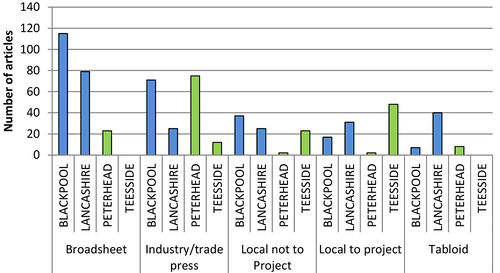
Stakeholder interviews
Twelve semi-structured interviews with stakeholders were conducted with representatives of local, national and European Government, NGOs, industry, and academia from the two case study regions (see Table 5 for summary of interview representatives). Interviewees were asked similar questions about both CCS and fracking, covering awareness of the technology and its impact on the local areas, arguments in favour and against the technology, siting decisions, information sources and sharing, influence of campaigning groups and community engagement. Interviews took place between July and September 2015 and lasted between 40 and 90 minutes. Interviews were conducted with seven stakeholders located within the Teesside area, three in Lancashire and two from national organisations providing services to local authorities.
| Teesside | Lancashire | National | |
| Local Government (elected representative) | 1 | 1 | |
| National Government (MP) | 1 | ||
| European Government (MEP) | 1 | ||
| Industry | 2 | ||
| NGO | 2 | ||
| Quasi-NGO (local Government umbrella groups) | 2 | ||
| Academic | 2 |
The timing of recruitment in the Lancashire area coincided with the decision on an application from Cuadrilla to Lancashire County Council for licences to commence exploratory drilling for shale gas in the nearby town of Preston. This application was extremely controversial locally and although permission was denied due to noise and traffic concerns, the prospect of an appeal remained[note 3]. Following up with those who had declined to be interviewed revealed a deep reluctance to discuss the technology, although there were no formal embargoes on discussing the subject from any of the organisations contacted, and despite the independence of the research team and its primary focus on CCS technology. Although we returned to recruitment in the Lancashire area following completion of the Teesside interviews, widening the geographical scope within the county from the initial focus in the Blackpool area, difficulties in securing interviews remained, and is reflected in the small number of stakeholder interviews in this area. Three interviews were completed in relation to the Lancashire case study: a senior elected local government representative and two academics, both of whom have an in depth knowledge of the case study area and its recent history of shale gas development, one an energy research specialist, the other a legal and human rights expert.
CCS was viewed very positively by all of the stakeholders interviewed in the Teesside region, and potential economic benefits were identified as being particularly significant for the area in terms of maintaining the local chemical and process industry in the region, attracting investment and the associated local employment opportunities. Interviewees were asked about potential negative as well as the positive impacts of the technology — while some struggled to identify negatives, technology costs and who would bear them (NGO), possible public scepticism (MP) and concerns about possible leakage of stored CO2 (MEP) were raised.
Interviews with the Lancashire and national stakeholders were more focused on fracking with more limited discussion of CCS, due to a self-declared greater awareness and understanding of the former in relation to the region. Tensions between political priorities, particularly at a national level, and the regulatory process were identified by several stakeholders with respect to fracking. However, the scepticism associated with fracking was not voiced in relation to CCS by any of the interviewees in this region; CCS was also viewed in a broadly positive light by these stakeholders, the only concern, raised by an academic, related to any possible local impacts or leakage risks.
Stakeholders in both Lancashire and Teesside identified shortcomings in the current planning process, which was considered to lack transparency and tended to be combative, with poor dissemination as a factor that could erode trust in the governance of proposed technology projects. Both the regional and national stakeholders expressed a keen awareness of the long term impact on perceptions of a technology, such as fracking, once it becomes tarnished by high profile controversy. CCS was seen by respondents in both regions to be less controversial than fracking.
The interviews served two roles within the study: i) they provided further information on the social context and understanding around the development of the two technologies in the two case study regions, informing the focus group topic guides in Task 4.2; and ii) combined with analysis of twitter data, they enabled us to conduct a social network analysis (SNA) of stakeholder and community knowledge around CCS and shale gas for the Teesside area. The small sample of interviews in the Lancashire case study made the data unsuitable for completing an SNA in this region. The social network analysis (SNA) allows for the channels of CCS information to be mapped as well as provide a deeper understanding of participants’ understanding of CCS and in particular CO2 storage.
Social Network Analysis
Empirical data collected from the interviews for the SNA required each participant to name their sources of information about CCS and where they shared CCS information. In addition, online data was procured from Twitter using the Tweepy API for a discrete period immediately after the interviews were completed (Oct–Nov 2015) using search terms #CCS and variants (e.g. #Ccs, #ccs). A database was created in neo4j and mondo.db open software, and cleaned to ensure that it only contained tweets that were #CCS linked to text that included 'carbon' or 'capture' or 'CO2'.
The flow of CCS information between the offline network of stakeholders, holding both formal and informal roles, was examined to understand where it was sourced from and where it was shared. Responses from the interviews were used to create affiliation and attribute matrices for all the entities identified through the interviews (i.e. individuals, websites, media etc) that included name, gender, location, and affiliation of both the ego (a specific person being interviewed) and alters (the other entities within the network). An ego’s 'Get' network was drawn from the ties between the interviewee and their source of information (Figure 21). A 'Share' network was built up from the ties between an interviewee and the information recipient (Figure 22). The 'ego' networks for both 'Get' and 'Share' were manually stacked to identify any overlap between individuals' source and dissemination networks.
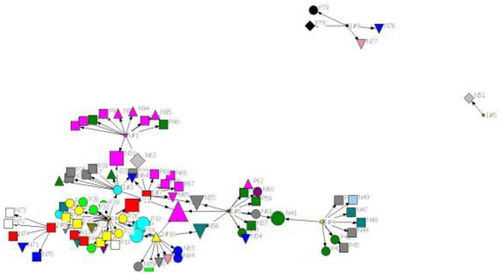
Both the offline ('Get' and 'Share' networks) and online (twitter #CCS) were visualized. The offline networks were visualised through SNA visualization tool NETDRAW and the output sociograms are related directly to the UCInet analysis with the layout of the figures being constrained by Euclidian distance; as such, the central nodes are located in the centre of the visualisation (Borgatti et al., 2002[8]). The online data was visualised using ORA (Carley et al., 2012[9]).
Analysis of the 'Get' network for CCS (Figure 21) highlights a number of important actors within this network. #2, a locally elected representative (yellow circle in the lower left quadrant) has many key connections, including a local council umbrella group (#7) and an academic (#3). Both academic information (magenta) and government information (taupe) are closely linked. Within the 'Share' network, there is a dense cluster of local nodes (yellow), with far more online sources shared (diamonds).
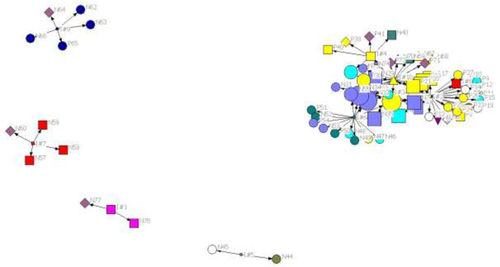
As illustrated in Table 6, the 'Share' network is smaller than the 'Get' network, with the 10 interviewees reporting 95 sources from which they sought information about CCS, and they shared CCS information with 77 others. Participants tended to get their information from national sources and share through local sources. Both academic and local council umbrella groups were at the centre of the 'Get' network, while information was more widely distributed through media outlets.

For the online element of the SNA, a database of 68 256 tweets was initially created in neo4j and mondo.db open software. #CCS was found to be non-unique to CCS, for example referring to a music festival in Caracas and a school, so once the tweets had been cleaned to only include #CCS with relation to carbon capture and storage a total of 930 original distinct tweets were collected during the study period. 386 of these were retweeted at least once, resulting in a total retweet count of 1363. The most influential tweet during the selected period of October - November 2015 was from a media source, announcing the cancellation of the £1bn carbon capture and storage competition in the UK. This information source was retweeted 118 times. The second most retweeted tweet was from the BBC. In addition to media outlets, politicians, industry representatives and research institutions were in the top retweeted tweets. From the 386 retweeted tweets, only 12 were retweeted more than 10 times (3.08% of n386). In the context of big data, utilizing the Twitter API which in itself has limitations and biases (Morstatter et al., 2013[10]), this dataset demonstrates that the #CCS network is currently small.
Citizen focus groups (Task 4.2)
Two focus groups were held with members of the lay public in Blackpool and Teesside on 7th and 21st November 2015, respectively. A professional company was employed to recruit focus group participants resident in the specified areas (maximum of ten people per group), screening was performed to ensure no participants were: a) employed in the shale gas or CCS industry; b) a member of a campaigning group relating to shale gas or CCS; or c) had previously participated in Focus Groups conducted by the research team; each participant received a £40 high street voucher. In each group, the focus was on CCS, and specifically storage and monitoring; this framing was consistent with the broader DiSSECS project objectives and sensitive both to the challenges encountered during the stakeholder interviews in relation to shale gas and potential public reactions. Each group was structured according to a common topic guide, which was designed to explore some of the themes that emerged during the stakeholder interviews and the extent to which the views of the public participants were consistent with those of the professional stakeholders. The project PI, Andy Chadwick, presented information about CCS in general, and storage and monitoring in particular to the groups; Andy remained available for questions following the two short presentations but left the room for the subsequent discussions. Each group lasted for 2 hours and was recorded, transcribed, and imported into Atlas.ti for thematic coding, by a minimum of two individual coders in order to ensure accuracy and lessen bias.
Each group was structured around topics covering the following themes:
- CCS: what it is, why we might need it
- CO2 storage: where it will be stored, how it will be monitored
- Exploring energy in the local context
The Lancashire Focus Group discussions were strongly influenced by previous, unanimously negative, experiences of fracking, with participants seeking reassurance that CCS was a different technology. This group’s initial responses to CCS focused on the possible impacts and risk associated with storage. In Teesside, the community was facing significant job losses due to the announcement of the closure of the steel works the preceding week and participants were focused on the benefits the technology might bring to the local economy. Further, Teesside participants echoed a sense of pride in the region’s industrial legacy that was also expressed by stakeholders, typically viewing CCS as an incremental technology applied to existing industrial activities. Concerns regarding the subsurface also differed depending on whether the storage and monitoring of CO2 was implemented onshore or offshore; in both groups a clear preference for offshore storage in the UK context was expressed. Both groups spontaneously raised the potential impact of natural earthquakes on the integrity of storage reservoirs, no-one raised concerns about the potential for CO2 storage to induce seismicity.
A critical factor in how conditions for achieving a social licence to operate might change over time is how experiences with other technologies or projects influence perceptions. This was particularly evident in the Lancashire group, where recent applications for licences to explore for shale gas had been highly controversial. When fracking was raised by this group it was in the context of how the council handled and responded to the planning applications but participants also initially evaluated potential impacts of CO2 storage with reference to experiences with fracking; both groups sought reassurance that CCS was different to fracking. Discussion in Teesside revealed a delicate balance whereby, despite living with and depending on large industrial installations, the underlying awareness of associated risks was ever present, even though there had been no major incidents in the area. Both focus groups articulated a greater level of trust in industry than local government to manage CO2 storage, typically expressing confidence in their technical competence, supporting the views expressed by the professional stakeholders. However, the strong trust in industry expressed in the Teesside group contrasted with a more mixed view evidenced in the Lancashire group.
Both Focus Groups discussed the interplay between communities, government and industry. In Lancashire, referring to the recent shale gas controversy, participants felt that the council had not listened to communities initially, perceiving a lack of response to community opposition until protest reached a certain point at which it could no longer be ignored. Perceptions of 'who pays for' and 'who benefits from' these technologies was another recurring theme in discussions, with costs and benefits expressed in both financial terms as well as in terms of risks and wider impacts, and whether projects may lead to longer term investment in a region’s industrial economy. Participants in the Teesside group clearly recognised the trade-offs involved with hosting the heavy industries in their local area. Nevertheless, there remains a delicate balance between achieving a situation in which residents identify the potential for a project to provide a variety of mutual benefits to communities and industry and one which prompts scepticism towards compensation schemes and erode the social licence (as expressed specifically in the context of fracking in Lancashire). Furthermore, in Lancashire, there was a sentiment that the industry and government were not interested in the concerns of the local community and their views of the technology, rather that they focused on financial profit, with a perceived disconnection from environmental issues in particular. Discursive responses were further supported by a poll of participants’ views on the extent to which they agreed/disagreed with a series of statements relating to CCS (Figures 23 to 27).
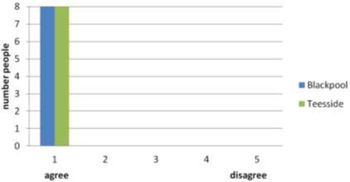
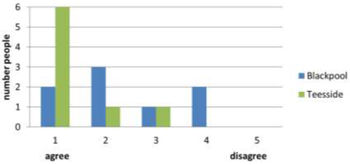
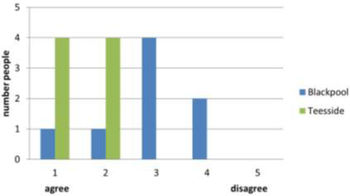
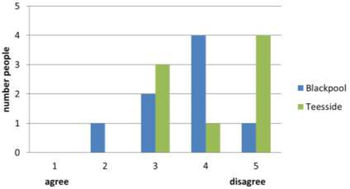
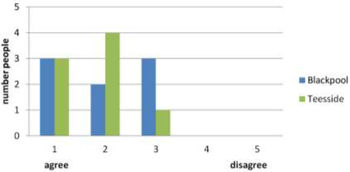
WP4 Conclusions
Social Network Analysis
This work offers insights into the relationships that have emerged between CCS actors and the flows of information within the offline CCS network in Teesside. These findings are useful for actors both looking to enhance CCS focused communication and dissemination within this region, but also for them to consider how this social network could be strengthened in order to better support their fight to deploy CCS within the region and more widely.
Both the offline and online information networks from this case study demonstrated that CCS retains a niche audience. Findings from the offline case study highlighted that participants tended to get their information from national sources and share through local sources. Both academic and local council umbrella groups were at the centre of the 'Get' network active in the offline network, while information was more widely distributed through media outlets. Elected representatives, local government umbrella groups and academics all provided a positive flow of information. The offline network was reasonably connected; however, the networks did not reach more broadly into the community, and remained more bound within industry, academia and local government. For implementation of a new technology such as CCS, where policy support and incentives are required from national government to support the work of local and regional government, a social network that is concentrated at the local and regional scale may not reach the seat of power. Although information and social capital exists within the network, is it being used effectively to reach those that matter and is the social capital that may be transferred within this network and beyond optimised? This niche knowledge network could result in a lack of policy pressure and lobbying power required to build a CCS coalition to push forward the technology.
In the online networks, it was national media outlets that held greater sway, however the social media (i.e. Twitter) analysis highlighted that CCS has yet to reach the general public, as even policy announcements and issues with local impacts, affecting jobs for example, don't 'stick' in the Twitter imagination. Awareness of CCS amongst the general public remains low, and social media has yet to emerge as a vehicle for raising that awareness. Whilst public awareness does not necessarily translate into successful deployment and implementation, familiarity can serve to inform the context within which broader discussions and debate can take place.
Bringing together both the data on offline and online knowledge networks, this research suggests a need for those looking to deploy and further CCS to reach outside their existing networks into wider communities, and in the case of social media, consider how CCS can be made unique.
Qualitative analysis (Media, interviews and Focus Groups)
This work package presents a body of empirical research exploring the social context in which a social licence to operate CCS might emerge, drawing on experience in the UK related to exploratory hydraulic fracturing for shale gas. Fracking technology has received a significant level of press attention in the UK in recent years, having been linked to induced seismicity in the north west of England, and has been associated with a series of high profile public protests at proposed sites; a controversial ongoing planning application in the Lancashire region at the time of the research has influenced stakeholder and lay responses in the local area. In contrast, the smaller number of media articles in the print press relating to CCS, dominated by articles in local or specialist publications, supports previous research findings that CCS has not yet captured the wider public imagination (European Commission, 2011[11]). While the arguments for and against shale gas technologies have been widely rehearsed in the press (see for example Jaspal and Nerlich, 2013[12]), the representation of CCS in the media is far from established — in terms of both volume and content.
Previous research has identified the importance of economic arguments framed in terms of investment, employment and leadership opportunities and the possible benefits that CCS might bring alongside reductions in greenhouse gas emissions (see for example (Boyd & Paveglio, 2014[13]; Nerlich & Jaspal, 2013[14]). The importance of the relationship between the press and key stakeholders in influencing opinions on the technology within civil society has also been identified (Buhr & Hansson, 2011[15]; Nerlich & Jaspal, 2013[14]). Results from empirical research presented here reinforce the importance of economic arguments for establishing CCS in the UK, from the perspectives of both stakeholders and local communities. This is particularly evident in the context of the Teesside study region where the local economy is dominated by a cluster of process industries which provide significant levels of employment in an economically deprived area. Furthermore, the establishment of the Teesside Collective is an important factor in enabling the region to benefit from, and establish trust with, the industry cluster; it plays a central role in developing the cluster, provides a point of contact for regional, national and international stakeholders and is active in providing press communications about it.
Conditions for establishing an SLO go beyond merely establishing the economic benefits of the technology; trust and confidence in the ability and motivations of public and private sector institutions to implement and manage the technology are critical. In the context of the fracking debate, while identifying the economic and employment benefits as arguments in favour of shale gas exploration, local residents expressed scepticism about the potential for shale gas to deliver these benefits. Furthermore, residents in Teesside are acutely aware of the trade-off that local communities make in accepting the physical risks that may come with the benefits of living alongside particular industries. However, a high level of confidence in the industry’s ability to manage CCS in Teesside was expressed by both stakeholders and lay participants alike, and a long history of pioneering industry in the Teesside region was repeatedly cited as grounds for trust in the companies involved. In contrast, in Lancashire, where companies involved in bringing fracking to the area have no such established reputation, the industry was viewed in the community with scepticism; focus group participants tended to express distrust in companies’ ability to collect reliable monitoring data (to ‘self-monitor’) and deemed companies to be driven by short term profit. This distrust in industry was compounded by perceived dissonance between different scales of governance; on top of perceived differences in political and policy priorities at local and national levels, shortcomings in the planning process were also seen by some stakeholders to contribute to an erosion of trust in planning and regulatory processes. Thus, perceptions of trust in the competence and motivations of key institutions are critical and dependent on past experiences with different technologies and the track record of those institutions in managing technological and industrial processes.
Both the regional and national stakeholders expressed a keen awareness of the long term impact on perceptions of a technology, such as fracking, that has become tarnished by high profile controversy. Past experience of previous technologies may influence participants’ opinions of other new technology; once trust is breached and SLO shifts, it can be difficult to rebuild, with the effects potentially spilling over to influence responses in the context of a different technology.
The foundation for establishing a social licence for CCS appears to be in place but consolidating and maintaining support for CCS depends on the evolving social, industrial and political landscape.
Footnote
- ↑ http://www.lancashire.gov.uk/council/planning/major-planning-applications/shale-gas-developments-in- lancashire.aspx [accessed 1st July 2016] http://www.teessidecollective.co.uk/ [accessed 1 August 2016 ]
- ↑ http://www.teessidecollective.co.uk/
- ↑ Lancashire County Council, Shale gas developments in Lancashire, http://www.lancashire.gov.uk/council/planning/major-planning-applications/shale-gas-developments-in- lancashire.aspx; 2016
References
- ↑ Batel, S, Devine-Wright, P, & Tangeland, T. 2013. Social acceptance of low carbon energy and associated infrastructures: A critical discussion. Energy Policy 58, 1–5.
- ↑ Ashworth, P, Bradbury, J, Wade, S, Ynke Feenstra, C F J, Greenberg, S, Hund, G, & Mikunda, T. 2012. What's in store: Lessons from implementing CCS. International Journal of Greenhouse Gas Control 9, 402–409.
- ↑ Bradbury, J, Ray, I, Peterson, T, Wade, S, Wong-Parodi, G, & Feldpausch, A. 2009. The Role of Social Factors in Shaping Public Perceptions of CCS: Results of Multi-State Focus Group Interviews in the U.S. Energy Procedia 1, 4665–4672.
- ↑ 4.0 4.1 Dowd, A-M, & James, M. 2014. A Social Licence for Carbon Dioxide Capture and Storage: How Engineers and Managers Describe Community Relations. Social Epistemology 28, 364–384.
- ↑ Herzog, H, & Wolff, J. 2014. What lessons can hydraulic fracturing teach CCS about social acceptance? Energy Procedia 63, 7024–7042.
- ↑ DECC, 2014. Fracking UK shale: understanding earthquake risk, in: Change, D.o.E.a.C. (Ed.), London.
- ↑ Pater, C J d, & Baisch, S. 2011. Geomechanical Study of Bowland Shale Seismicity, Synthesis Report. Cuadrilla Resources.
- ↑ Borgatti, S P, Everett, M G, & Freeman, L C. 2002. Ucinet for Windows: Software for Social Network Analysis. Analytic Technologies, Harvard, MA.
- ↑ Carley, S R, Pfeffer, J, Reminga, J, Storrick, J, & Columbus, D. 2012. ORA User's Guide 2012 No. CMU-ISR-12-105. Inst of Software Research Internat, Carnegie-Mellon Univ Pittsburgh PA.
- ↑ Morstatter, F, Pfeffer, J, Liu, H, & Carley, K M. 2013. Is this Sample Good Enough? Comparing Data from Twitter's Streaming API with Twitter's Firehose, International AAAI COnference on Weblogs an Social Media (ICWSM), Boston, MA, 400–408.
- ↑ European Commission, 2011. Special Eurobarometer 364: Public awareness and acceptance of CO2 capture and storage, Brussels: European Commission; 2011.
- ↑ Jaspal, R, & Nerlich, B. 2013. Fracking in the UK press: Threat dynamics in an unfolding debate. Public Understanding of Science 23, 348–363.
- ↑ Boyd, A D, & Paveglio, T B. 2014. Front page or buried beneath the fold? Media coverage of carbon capture and storage. Public Understanding of Science 23, 411–427.
- ↑ 14.0 14.1 Nerlich, B, & Jaspal, R. 2013. UK media representations of Carbon Capture and Storage, Actors, frames and metaphors. Metaphor and the social world 3, 35–53.
- ↑ Buhr, K, & Hansson, A. 2011. Capturing the stories of corporations: A comparison of media debates on carbon capture and storage in Norway and Sweden. Global Environmental Change 21, 336–345.